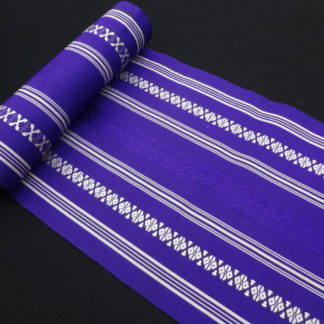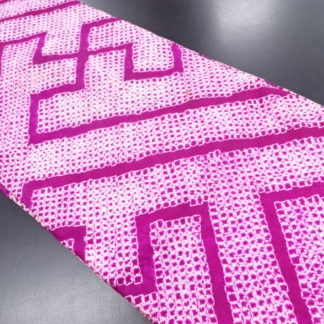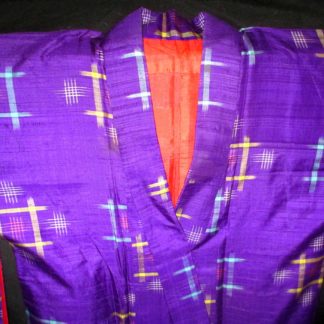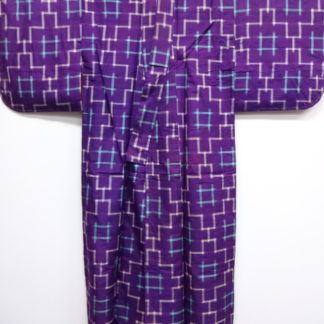Description
Antique meisen woven igeta kimono
Lovely antique meisen silk kimono with a woven igeta pattern in white and blue on a purple ground. Lined in khaki-yellow silk at lower edges and sleeves, and cotton in the rest of the kimono. In very good condition for its age, which would date from the Taisho period of around 1912-26.
It measures 130 cm long, 62 cm from centre to sleeve edge, and the sleeve drop is 45 cm.
Gorgeous bold colours and design, a really nice kimono for a man or a woman, and showing very nice soft edges to the patterning typical of meisen silks.
The dyeing method is similar to Indonesian Ikat method. This would be a double ikat, as both warp and weft threads are dyed before weaving.
This would suit a man or a woman equally well, and could also be used for cosplay.
• Igeta: One of the kimono patterns. It looks like the mouth of a Japanese traditional well, which looks rather like a noughts and crosses (tic tac toe) grid
• Ikat: Ikat fabric is made (dying the threads before they are woven so the pattern emerges on the loom. It is a fascinating process and one that, once you recognize it on cloth, will be sure to make you wonder about the time and skill involved in creating it. The technique is sometimes called “fuzzy weave” since the patterning is often blurred because even the most accurate dying and weaving may not align the differently dyed threads exactly. When only the warp threads are ikat-dyed, this is a single ikat and you will see the “fuzziness” running in only one direction. When both the warp and weft threads are dyed before weaving, this is a double ikat and the fuzziness runs in both directions
• Meisen: Meisen silk, generally crisp and supple, is one of the Japanese silks fabricated by weaving pre-dyed threads, utilizing the tie-and-resist ikat technique (ikat is an Indonesian term widely utilized to refer to this technique).
In this process, the threads, silk or cotton, are first stretched on a frame. Selected design areas are tightly bound to prevent the dye from penetrating and the hanks of threads are immersed in the dye pots. The bound portions of the yarns resist the dye and when woven, as a result of the threads not being perfectly aligned, create shapes with charmingly uneven edges.
Other Japanese textiles that are made with variations of this technique are cotton kasuri,omeshisilk and tsumugi silk..
Meisen silk was a popular fabric for casual kimono from 1910 to 1950, in part because it was more affordable, and in part because the designs, frequently drawing on Western influences, seemed adventurous and innovative. Even today they retain a contemporary sensibility.




















Reviews
There are no reviews yet.